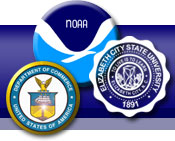1.
Output: The proposed program is expected to have the following
outputs:
a. Intensive training for six undergraduates per year in
remote sensing techniques.
b. Practical research experience for six undergraduates
per summer. Students would use their expertise in remote
sensing to address real research needs relating to NOAA’s
mission and will have an opportunity to see what the life
of a scientist is like.
c. Exposure of up to 40 students per year to the concepts
of entrepreneurship and creative thinking.
d. Exposure of up to 40 students per year to researchers
using remote sensing techniques to address scientific questions
relevant to NOAA’s mission.
e. Experience for six students per year in writing scientific
reports.
f. Experience for six students per year in public speaking
and presentation of scientific research.
g. Experience for up to six students per year in writing
grant proposals (to attain another year of funded research).
h. Additional research experience in years two and three
for up to six students per year. This opportunity will encourage
students who really want to work with remote sensing techniques
or with the scientific questions that the techniques address
to continue to explore this career option.
i. Research reports by summer interns generated by six students
per year.
j. Experience for 6 students per year to attend national
or regional scientific meetings to meet other scientists
and to become acquainted with the culture of scientific
meetings.
2.
Evaluation of the program would be made by compiling:
a. Supervisor reports of student activities, including an
evaluation of student preparedness.
b. Student evaluations of their intern research experience,
including report of research activities and self-assessment
of preparedness.
c. Student evaluations of the quality and relevance of their
training in remote sensing and GIS.
d. The number of students who apply for internships each
year of the program.
e. The number of first year interns who apply for a second
year of work with the same agency.
f. The number of researchers who request or inquire about
interns each year.
The
reports and evaluations listed above (a. through c.) would
be compiled and summarized in a qualitative review of the
program. For the last four measures (d., e., and f.), increasing
numbers would be considered an indication of success.
3.
The proposed project would have the following benefits:
a. It would provide high quality training in remote sensing
techniques to students from a minority-serving institution.
Students would receive a strong background in the theory
of interpreting satellite imagery, would have individualized
training and would gain practical experience in applying
these techniques.
b. It would encourage students with diverse backgrounds
to pursue careers in remote sensing technology or to pursue
careers in scientific fields using these tools. The project
would not only provide the students with the knowledge needed
to work with remote sensing, but will develop the personal
relationships (with summer supervisors and the program manager)
that are vital to helping students envisage continuing to
work in this field.
c. It would introduce undergraduate students to the process
of doing science and of communicating to other scientists
through report writing, grant writing, and attendance at
scientific meetings.
d. It would expose students from a Historically Black College
to scientists working in NOAA laboratories and would provide
a stepping stone for the students to careers in NOAA.
e. It would encourage the students to approach their career
choices in an entrepreneurial spirit, whether or not the
students actually go into business using the skills they
develop in the program.
f. It would greatly enhance the ability of ECSU’s
Center of Excellence in Remote Sensing Education and Research
to teach remote sensing techniques.
g. It would provide trained, psychologically prepared interns
who can actively contribute to the research at NOAA laboratories
during the summer. Student interns would have skills needed
by NOAA researchers and who would be able to contribute
directly to NOAA’s mission.

